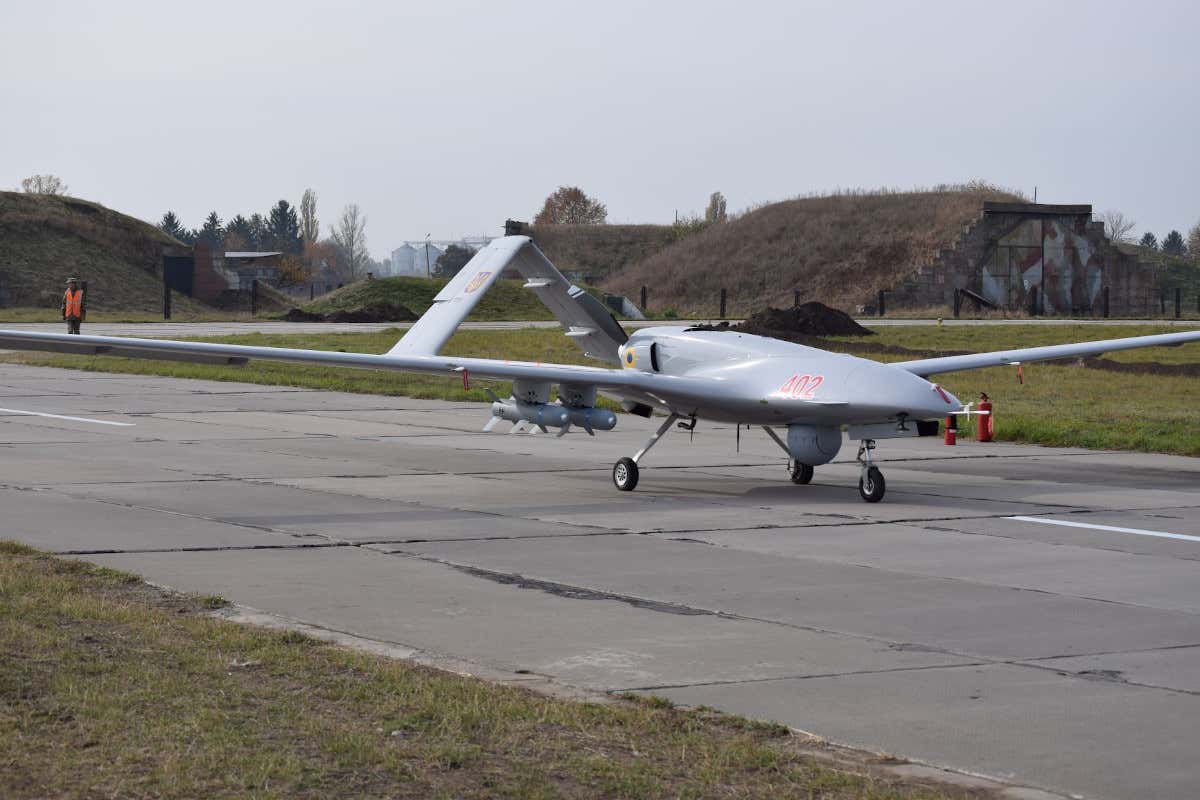The US Defense Department announced its latest assistance package for Ukraine this week. Top on the list of items in this assistance package is a “laser-guided rocket system” that can further bolster Ukraine’s fleet of Bayraktar TB2 drones.
Sea-Skimming Missiles – Australian Experts Call China’s Deadly ASCMs The Biggest Threat To Allied Navies
Traditionally, any rocket with a guidance system is called a missile however in the US military ‘guided rocket’ refers to the stock of 70 mm/2.75-inch Hydra 70 unguided rockets that have been turned into precision-guided munitions (PGMs) using laser guidance kit.
So far, the Ukrainian resistance has impressively employed its small fleet of TB2 drones against the invading Russian military which happens to be one of the world’s largest armed forces.
The Turkish-made drones have become a sort of legend in Ukraine’s guerrilla force making headlines every day and social media is proliferated with posts of numerous video footage from Bayraktar drones either itself striking or guiding the artillery strikes against Russian military targets.
The Ukrainian military has used TB2 for reconnaissance, surveillance, suppression of enemy air defenses (SEAD) operations, and battlefield destruction.
🔥A Bayraktar drone destroyed a #Russian "Buk" near #Zhytomyr pic.twitter.com/NmOTOIqJuo
— NEXTA (@nexta_tv) February 27, 2022
TB2s have destroyed Russian Buk medium-range surface-to-air missile (SAM) launchers enabling the Ukrainian air force to continue operating for more than a month into the war; struck Russian convoys, thereby hindering the much-needed supplies to the frontlines; and neutralized Russian tanks and various other types of armored vehicles, etc.
Meanwhile, Russia has claimed that its armed forces have destroyed 37 of the Ukrainian Bayraktars, the evidence so far exists only for three of these and the TB2s still appear to be operating.
However, of late, fewer videos have appeared of TB2 strikes as more of them are seen identifying targets and directing the artillery fire towards them, suggesting a date shortage of laser-guided MAM missiles also supplied by Turkey.
#Ukraine: Apparently, we have the third verified loss of the Ukrainian Bayraktar TB2 UCAV. This one was shot down by the Russian army in #Kherson Oblast. Date is unknown. pic.twitter.com/NDIMYHefZr
— 🇺🇦 Ukraine Weapons Tracker (@UAWeapons) April 2, 2022
While the US and European countries have been actively providing Ukraine with weapons since the beginning of the Russian invasion, Turkey has refrained from supplying arms possibly because of Russian pressure.
Turkey supplied an extra consignment of Bayraktars shortly before the invasion but the country finds itself in a difficult position between supporting Ukraine and opposing Russia because of its dependence on the latter for its energy needs.

Turkish officials have maintained that the drone sale was a private deal between a Turkish company and Ukraine and not military assistance from the government.
In such a situation, the US seems to have come up with a solution to give the teeth to Ukraine’s fleet of TB2s by arming them with its lightweight, laser-guided Advanced Precision Kill Weapon, or APKWS which is an upgrade for the US military’s vast stocks of old Hydra 70 rockets.
These 25-pound 70 mm rockets were developed way back in the 1940s, carried in pods of seven or nineteen by attack aircraft and helicopters, and fired in volleys to cover an entire area. The US used them extensively in Vietnam and Russian helicopters are still firing pods of similar unguided rockets in Ukraine.
In 2005, the US Army started a new development program called APKWS II and BAE Systems was selected as the prime contractor for the program, while other contractors included General Dynamics and Northrop Grumman.
The BAE systems fitted the APKWS with its distributed aperture semi-active laser seeker (DASALS) guidance and control system to convert the unguided Hydra 70 rocket into precision munitions which enables them to engage soft and lightly armored targets in restricted areas with minimal collateral damage.
The semi-active laser-guided rocket system consists of 3 main components which include M151 / MK152 and M282 warheads, M423 / MK435 fuse, and a standard MK66 rocket motor.
The rocket system has wing assemblies and folding fins with a low-cost laser seeker located on the leading edge of these folding fins working in unison as a single seeker which allows existing warheads from the Hydra 70 system to be used without the need for a laser seeker in the nose of the missile.
The weapon system is also fitted with a MEMS inertial measurement unit and advanced digital signal processing technique for improved communication.
The system works with standard laser designators which involve the operator highlighting the target for the rocket to home in on it. It is known to have a range of over 4.83 km from a helicopter or 11.27 km from a fixed-wing aircraft which has been increased by 30% after a software upgrade by BAE Systems in 2021.
The rocket system can be deployed against ground, air, and sea-based threats and can also be used for close air support operations.
The Bayraktar drones have never fired an APKWS before but it is said to be able to fire the CİRİT missile made by Turkish company Roketsan which is also a 70mm laser-guided rocket compatible with NATO standard laser designators and can be launched from existing aircraft-mounted rails and pods.
Also, the APKSW is light in weight as compared to the current MAM missiles used by Ukrainian TB2s that can allow the drone to carry 6 or more APKWS instead of 4 MAM.
So, it would be interesting to see if the APKSW system is indeed deployed using Barayktars and what impact it will have on the ongoing Ukraine war.
- Contact the author at etdesk@eurasiantimes.com
- Follow EurAsian Times on Google News